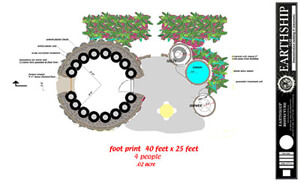A house made of 13,500 plastic bottles was built by a retired proffesor of mathematics Tomislav Radovanovič. Only the foundation is made of concrete. With the help of his students, compeltion of this house took the builder 5 years. Not only the floor, the walls and the columns and the roof is made of plastics, the house is also equipped with articles made of PET bottles. The kitchen table and the chairs, the lights and even the bathroom was designed from plastics. Some bottles are filled with concrete. some with silicon and the rest is left empty. The shape of the bottles is changed in some cases with the use of heat and wooden or steel mould. Some decorative pieces were painted by the author. Additionally 2500 caps were used just for decoration.
Bottle School in Rizal Laguna
The My Shelter foundation (led by Illac Angelo Diaz) acquired site from the local government in San Pablo and sponsorship by Pepsi to build their first PET bottle school in Asia on the Philippines. For the school construction, 9000 PET bottles were collected during a public run in San Pablo and filled with mud, sand, straws, and even manure, all of this mixed with water. The space between the bottles is also filled with adobe which later simply dries in the sun. The structure is strenghtened by steel bars.
There exist several examples of such schools, most often realized by non-governmental organisations, such as My Shelter and Hug it Forward. Building the object is usually just visible result of primar intentions: community support together with cleaner landscape. The latter has already built a number of schools in Guatemala. The precursor of Hug it Forward is the independent organization Pura-vida founded by Susana Heisse in 2005.
Campo Cielo
Campo Cielo, Honduras, 2004
Campo Cielo is a sort of club room for women realized in Tegucigalpa, Honduras, 2004 by Andreas Froese. It offers shelter for about eight people. The building has an integrated water tank which required that cement had to be used in order to protect the earth mortar from water.
Froese usually does not apply cement in the walls of the buildings, but rather relies on earth mortar to stick the PET bottles together (see for example also the Trivadrum Cerala in India on this page).
Rescue object on Haiti
Haiti Eco Living Project – H.E.L.P.
After we finish up our prototype demonstration Earthship at the Grassroots compound in late January, 2011, we are taking what we learned from that and what we have absorbed from our time spent with the Haitian people and attempting to move forward with project H.E.L.P. – Haiti Eco Living Project. Groups of Earthships the Haitian people can build themselves that are absolutely sustainable. These Earthships are built using materials found in and around Port-Au-Prince.





